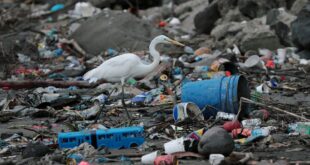If we could mine the asteroid, it could be worth $10,000 quadrillion (yes, that’s a real number).

Hot on the heels of the sample–return mission from an asteroid named Bennu, NASA is preparing to launch a spacecraft to yet another asteroid.
The Psyche mission — named after the asteroid it’s planning to study — is set to blast off on Thursday atop a SpaceX Falcon Heavy rocket from Cape Canaveral, Fla., where it will begin a six-year journey to its home in the asteroid belt.
Once it arrives, it will continue to orbit Psyche for two years, where it will study things such as its composition, age and topography.
So why is NASA heading to yet another asteroid?
As always, to better understand Earth.
Earth is made up of three layers: The crust, the mantle and the core. But because the core lies so deep within the planet, we know virtually nothing about it.
But out in the asteroid belt, home to a million objects or more, all left over from the formation of our solar system 4.5 billion years ago, may lie clues in the form of metal-rich asteroids. And Psyche is just one of those objects.
To date, astronomers have only been able to get information about the asteroid, offically named 16 Psyche, from NASA’s Hubble Space Telescope and the now-retired airborne Stratospheric Observatory for Infrared Astronomy (SOFIA) telescope.
But from that they’ve learned that the 280–kilometre wide, potato-shaped asteroid is likely metal-rich, unlike any asteroid we’ve ever visited.
“We have probably two million or more objects in our solar system,” said Lindy Elkins-Tanton, principal investigator of the Psyche mission. “We get kind of focused on the big planets, but there’s an awful lot more of these smaller objects. And they come in all different flavours and types. And they tell us different parts of the solar system story.”
In particular, scientists want to understand how the cores of rocky planets like Mercury, Venus, Earth and Mars formed and what they might look like.
“If you want to find out about metal cores, this is our very best bet,” said Elkins-Tanton, who is also a professor at Arizona State University’s school of Earth and space exploration.
“Because we cannot go to the cores of any of our rocky planets — way too hot, way too much pressure — but they make these magnetic fields that keep our atmosphere safe and give us guidance and have a really important aspect of habitability.”
There are two leading theories as to how Psyche formed. One, is that it was in the stage of potentially forming as a planet, called a planetesimal, but another body slammed into it, stripping away its upper crust leaving behind a metal core.
Another theory is that it was left over from the formation of our solar system and migrated outwards from the sun where it now resides in the asteroid belt.
But scientists may be wrong about both theories.
“Psyche is so cool, because we still don’t really know what it is,” said Zoe Landsman, a research scientist at the University of Central Florida, and chief scientist at the Center for Lunar and Asteroid Surface Science (CLASS).
Though not involved in the mission, Landsman has studied Psyche in depth and is excited about what surprises may lie in store with this mission. Psyche may not even look like we think it does.
“There’s really nothing that beats actually sending a spacecraft to the object. And I think every single time that we’ve gone to a new world, there’s something that completely subverts our expectations, and you learn something tremendously valuable about the solar system.”
Worth $10,000 quadrillion
In 2017, Elkins-Tanton calculated just how much Psyche might be worth, coming in at a whopping $10,000 quadrillion USD, should we ever have the resources to mine it.
But, she noted while speaking with CBC, there are some caveats.
“We have no technology for bringing Psyche back to Earth. There isn’t any way to do that. And then if we did, it would probably be a really bad day on Earth, because we also have no technology for putting it into a stable orbit,” she said. And then, even if we could do that, we would have flooded the market and it would be worth nothing.”
While space mining may seem like science fiction, such as seen in the cult-favourite book and television series The Expanse, scientists imagine it happening one day.
Space mining is certainly something currently discussed in the space industry — there’s even a newly formed Canadian Space Mining Corporation, though many space mining companies have come and gone.

“I do think that we could have people mining in the asteroid belt,” Elkins-Tanton said. “In a lot of weird ways that is a plausible future.”
Gordon Osinski, a planetary geologist at Western University in London, Ont., who is not involved in the Psyche mission, but who is the principal investigator for Canada’s first lunar rover, agreed, though he wonders about the timing.
“I think it’s inevitable,” he said. “It’s a question of when. I think it will happen on the moon first, because of its proximity, and it will be water.” Specifically, he said, the mining of resources in situ, or in the place you are visiting, would be practically necessary in order to build bases on planets or moons.
He also noted that Natural Resources Canada mentioned the future of space mining it a recent report titled The Canadian Minerals and Metals Plan.
However, he believes the mining of asteroids is much further away, but there could be a lot of good reasons to try, including the mining of valuable platinum group elements, or PGEs, which are used in such things as batteries, solar panels, and even pacemakers and magnets.
But no matter what the future holds in terms of further space exploration and mining opportunities, Elkins-Tanton said she’s pumped about the upcoming mission, but she’ll feel better once it’s safely on its way to the asteroid
“I’m totally psyched about Psyche,” she said. “And I hope that everyone is psyched about Psyche. It’s been really fun to get so much support from around the world. People are very intrigued by this mission.”
ABOUT THE AUTHOR

Senior reporter, science
Based in Toronto, Nicole covers all things science for CBC News. As an amateur astronomer, Nicole can be found looking up at the night sky appreciating the marvels of our universe. She is the editor of the Journal of the Royal Astronomical Society of Canada and the author of several books. In 2021, she won the Kavli Science Journalism Award from the American Association for the Advancement of Science for a Quirks and Quarks audio special on the history and future of Black people in science. You can send her story ideas at Nicole.Mortillaro@cbc.ca.
*****
Credit belongs to : www.cbc.ca
 Atin Ito First Filipino Community Newspaper in Ontario
Atin Ito First Filipino Community Newspaper in Ontario






